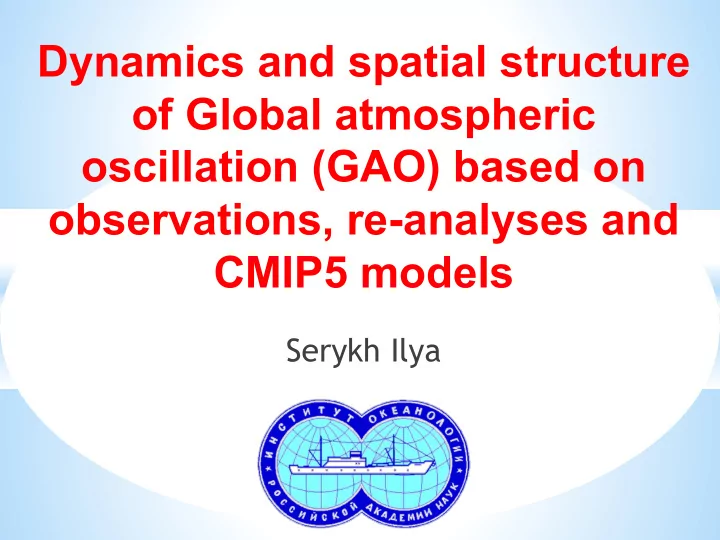

Dynamics and spatial structure of Global atmospheric oscillation (GAO) based on observations, re-analyses and CMIP5 models Serykh Ilya
El Niño Average SST anomalies for 35 El Niño (SSTa > +0.5 °C) Duration of the anomalies must be longer than 5 months. La Niña Average SST anomalies for 32 La Niña (SSTa < -0.5 °C) Data from COBE SST for 1891-2014
Figures El Niño from 2015/16
Figures from 2014 2015 NCEP NOAA Climate Prediction Centre ENSO Diagnostic Discussion Archive
GAO a) The spatial structure of the Global Atmospheric Oscillation (GAO) in the smoothed monthly near-surface temperature distribution over the 1920-2016. t b) The spatial structure of the Student t -test values of statistical significance of nonzero differences between the near-surface temperature corresponding to El Niño and La Niña events observed during the 1920-2016. Data from HadCRUT4
GAO a) The spatial structure of the Global Atmospheric Oscillation (GAO) in the smoothed monthly sea level pressure distribution over the 1920-2016. b) The spatial structure of the Student t -test values of statistical significance of nonzero differences between the sea level pressure corresponding to El Niño and La Niña events observed during the 1920-2016. Data from HadSLP2
Spatio-temporal diagram of the sea- level atmospheric pressure GAO evolution in the planetary belt of (30N-30S) The speed of the eastward propagation of the sea-level pressure GAO anomalies is the same that the speed of the Chandlerian Pole tide propagation!!! Data from HadSLP2
Differences and t-Student test between geopotential heights of GAO at different geopotential height levels Data from NCEP/NCAR 1948-2012 250 hPa 400 hPa 600 hPa 850 hPa 1000 hPa
HadCRUT HadSLP2 HadSLP2 HadCRUT.4.4 20thC_ReanV2c 20thC_ReanV2c 20thC_ReanV2c JRA-55 JRA-55 JRA-55 NCEP/NCAR NCEP/NCAR NCEP/NCAR ERA-20C ERA-20C ERA-20C Correlations between GAO and ENSO
Spectra of ENSO and GAO Power spectra of the time series of the monthly mean values of EONI (a) and ESOI (b) represented as mappings on the El Nino (a) and GAO (b) spectra computed for monthly data over annual period (red line) as well as represented with maximal the period 1920-2016. Initial data were taken from HadISST and spectral resolution (blue line), and calculated over the 1870- HadSLP2. The annual cycle and its superharmonics are filtered 2014 year period. out from the spectra. Red lines correspond to the "red noise" Data from HadCRUTEM4, imitations of the spectra. The 95%- and 5%-quantiles of the "red noise" spectra also are shown. HadISST and HadSLP2
Detailed view of the Niño3+Niño3.4 spectral band of time scales 3c 4c 1.2 y – Chandler wobble (c) 1/2s 1/5m 1/4m 11.2 y – Sun-spots activity (s) 1/3s 18.6 y – Moon-sun nutation (m) 5c 2c 1/4s 1/3m 1/6m 9c 8c 1/2m 6c 7c Data from HadCRUTEM4
20th Century Reanalysis ACCESS1-3 CESM1-CAM5 CanESM2 CMCC-CM CNRM-CM5 GFDL-CM3 HadGEM2-ES INM-CM4 MPI-ESM-MR MRI-CGCM3 NorESM1-M
20th Century Reanalysis ACCESS1-3 CESM1-CAM5 CanESM2 CMCC-CM CNRM-CM5 GFDL-CM3 HadGEM2-ES INM-CM4 MPI-ESM-MR MRI-CGCM3 NorESM1-M
Power CESM1-CAM5 spectra of 20th Century Reanalysis v2c ACCESS1-3 the EONI (red) and ESOI (blue) computed from the NOAA CIRES 20th CMCC-CM CNRM-CM5 CanESM2 Century Reanalysis, as well as INM-CM4 from the outputs of the best of GFDL-CM3 HadGEM2-ES the CMIP5- models Historical experiment. MPI-ESM-MR MRI-CGCM3 NorESM1-M
Comparing of the experiments Historical (with solar forcing) and piControl (with no forcing) for CESM1-CAM5 (NCAR) model
Dynamics of the Global Atmospheric Oscillation (GAO) Lag in months Correlations with lag from -22 to +22 months between EONI (anomalies of SST in Niño 3.4 + Niño 3 + Niño 2 regions) and the sea-level atmospheric pressure for the period 1871-2011. Data from 20thC_ReanV2c
Recommend
More recommend